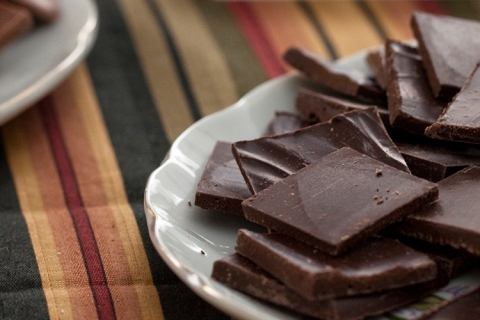Unlock Your Lover's Heart - with Chocolate
By Guido Masé, RH (AHG), Chief Herbalist at Urban Moonshine
Love, death, rebirth – such is the cycle of fertility and renewal. Perhaps none knew this better than the Mesoamerican cultures that dwelled in present-day Mexico and Central America. Over one thousand years ago, in the rainforest that covers the slopes of the mountains in Western Yucatán, a Maya ruler enshrined this allegory on the lid of his tomb – in a story told by plants.
Pakal the great, who ruled Palenque for over sixty years, is pictured in a state of transition: beneath him opens the mouth of the serpent of the underworld while above him, sprouting from his belly, a tree of life fills the sky. Pakal embodies the corn god, who dies, buries himself, and is reborn as magical plants: most notably, the cacao tree[i].
The ancient Maya, along with the Olmec before them and the Aztec after, revered cacao and its chocolate preparations. These were most often liquid and used for love and fertility as much as for sustenance and renewal. The healers of these cultures, who saw no separation between body and spirit and sought to nurture ch’ulel, or “life-force”[ii], knew that cacao works on that key nexus of love and life: the human heart. In fact, cacao pods full of liquid chocolate were used ritually as a stand-in for a sacrificial heart[iii]: dark, red, thick as blood, eating cacao renewed this all-important organ.
Some may say that love requires a strong and open heart, and when we speak of lost love, we still call it a broken heart. Sexual arousal and pleasure also thrive on love, and a strong circulation and blood flow are required for making love. This all – love, heart, blood, arousal – is wrapped together fairly inextricably, just as the ancient Maya said, and we are seeing in the modern research record that chocolate works on this deep knot of human nature. While cacao has always been legendary for its effects on libido, sexual function, and attraction[iv], today we are learning more and more about its powerful effects on the cardiovascular system.
Chocolate, with regular use, seems to provide excellent support for the heart and blood vessels. Reviews of clinical research focus on stroke prevention in men[v] and women[vi], blood pressure control[vii], heart disease prevention[viii], and improved blood flow due to more dilated, or “open”, vessels[ix]. It turns out that a healthy cardiovascular system may be one of the most important factors for good sexual arousal[x]: the two go hand-in-hand, a fact as true for men as it is for women. This makes even more sense when you learn that chocolate can help support micro-circulation and sensation in the skin and erogenous zones of the body[xi]. The tissue has to be warm, full of blood, and super-sensitive for arousal to take place.
To me, the lesson chocolate offers is that we are all lovers at heart – but that we must consistently renew our hearts, as we renew our love, to maintain openness and trust. Through these open channels passion and desire are sure to flow, but so are blood and life-force. A good heart means great sex, just as great sex nourishes the heart. And chocolate strengthens both together! What a perfect ritual to share, for intimacy but also long life.
Herbalists can enhance and amplify the flavor and benefits of chocolate using a little sweet honey and herbs, much as the ancient Maya did, to create the perfect heart-healthy aphrodisiac formula. Generally, spicy plants such as cayenne (Capsicum annuum) or damiana (Turnera diffusa), both native to the same region where cacao is found wild; circulatory support from botanicals like hawthorn berry (Crataegus spp.); and tonics like maca (Lepidium meyenii) or ashwagandha (Withania somnifera) are all combined to reinforce the arousal, circulatory stimulation, and vitality enhancement of the chocolate. You may come to these potions as a great treat to get closer to your partner, or as a delicious way to keep your blood vessels healthy. But in either case, you will experience renewal just as the ancient cacao lords did, and unlock your lover’s heart.
Guido Masé is a clinical herbalist, herbal educator, and garden steward specializing in holistic Western herbalism, though his approach is eclectic and draws upon many influences. Guido works clinically and teaches at the Vermont Center for Integrative Herbalism. He and his students offer free herbal consultations at City Market on Monday evenings.
[i] Martin, Simon. Cacao in Ancient Maya Religion: First Fruit from the Maize Tree and other Tales from the Underworld. In Chocolate in Mesoamerica: A Cultural History of Cacao, edited by Cameron L. McNeil, pp.154-183. University Press of Florida, 2006.
[ii] Bley, Bonnie. The Ancient Maya and their City of Tulum, p.31. iUniverse, 2011.
[iii] Coe, Sophie D., and Michael D. Coe. The True History of Chocolate. Thames and Hudson, New York, 2007.
[iv] Bianchi-Demicheli, Francesco. "Sexualité, cœur et chocolat." Sexologie clinique 378.11 (2013): 624-629.
[v] Larsson, Susanna C., Jarmo Virtamo, and Alicja Wolk. "Chocolate consumption and risk of stroke A prospective cohort of men and meta-analysis." Neurology 79.12 (2012): 1223-1229.
[vi] Larsson, Susanna C., Jarmo Virtamo, and Alicja Wolk. "Chocolate consumption and risk of stroke in women." Journal of the American College of Cardiology 58.17 (2011): 1828-1829.
[vii] Ried, Karin, et al. "Effect of cocoa on blood pressure." Cochrane Database Syst Rev 8 (2012).
[viii] Buitrago-Lopez, Adriana, et al. "Chocolate consumption and cardiometabolic disorders: systematic review and meta-analysis." BMJ: British Medical Journal 343 (2011).
[ix] Hooper, Lee, et al. "Effects of chocolate, cocoa, and flavan-3-ols on cardiovascular health: a systematic review and meta-analysis of randomized trials." The American journal of clinical nutrition 95.3 (2012): 740-751.
[x] Wincze, John P., and Michael P. Carey. Sexual dysfunction: A guide for assessment and treatment. pp23-39. Guilford Press, 2012.
[xi] Neukam, Karin, et al. "Consumption of flavanol-rich cocoa acutely increases microcirculation in human skin." European journal of nutrition 46.1 (2007): 53-56.
